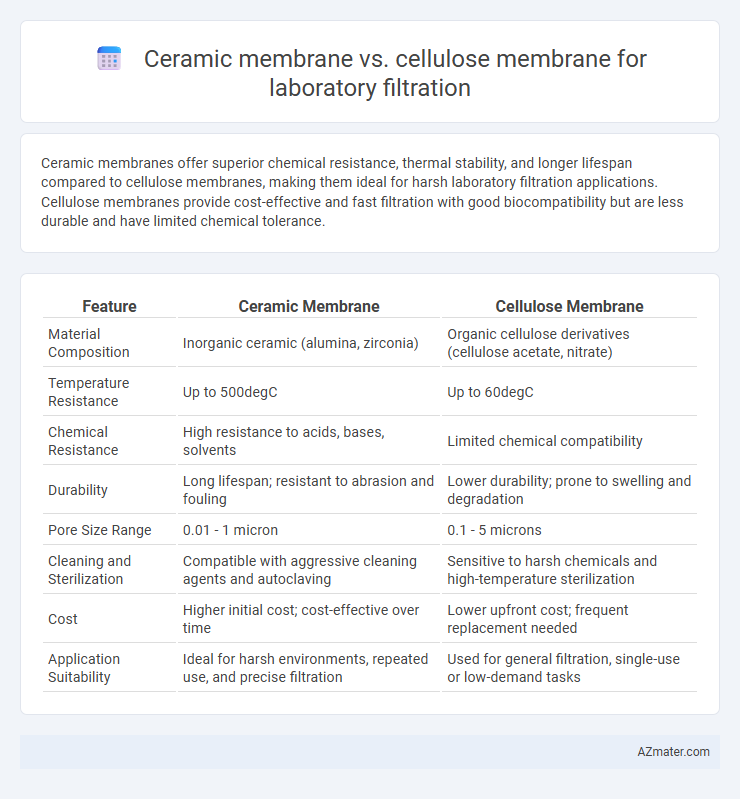Ceramic membranes offer superior chemical resistance, thermal stability, and longer lifespan compared to cellulose membranes, making them ideal for harsh laboratory filtration applications. Cellulose membranes provide cost-effective and fast filtration with good biocompatibility but are less durable and have limited chemical tolerance.
Table of Comparison
| Feature | Ceramic Membrane | Cellulose Membrane |
|---|---|---|
| Material Composition | Inorganic ceramic (alumina, zirconia) | Organic cellulose derivatives (cellulose acetate, nitrate) |
| Temperature Resistance | Up to 500degC | Up to 60degC |
| Chemical Resistance | High resistance to acids, bases, solvents | Limited chemical compatibility |
| Durability | Long lifespan; resistant to abrasion and fouling | Lower durability; prone to swelling and degradation |
| Pore Size Range | 0.01 - 1 micron | 0.1 - 5 microns |
| Cleaning and Sterilization | Compatible with aggressive cleaning agents and autoclaving | Sensitive to harsh chemicals and high-temperature sterilization |
| Cost | Higher initial cost; cost-effective over time | Lower upfront cost; frequent replacement needed |
| Application Suitability | Ideal for harsh environments, repeated use, and precise filtration | Used for general filtration, single-use or low-demand tasks |
Introduction to Laboratory Membrane Filtration
Laboratory membrane filtration utilizes ceramic membranes and cellulose membranes to separate particles based on size and chemical properties, with ceramic membranes offering superior chemical resistance and thermal stability ideal for harsh or high-temperature conditions. Cellulose membranes, made from natural polymers, provide cost-effective filtration suited for aqueous solutions and biological samples but have lower resistance to solvents and extreme pH levels. Choosing between ceramic and cellulose membranes depends on the sample matrix, desired filtration precision, and compatibility with laboratory reagents.
Overview of Ceramic and Cellulose Membranes
Ceramic membranes offer high chemical, thermal, and mechanical stability, making them ideal for harsh laboratory filtration conditions involving aggressive solvents or extreme pH levels. Cellulose membranes, composed of regenerated cellulose or cellulose acetate, provide excellent hydrophilicity and biocompatibility, commonly used for sterile filtration and biological sample preparation. Ceramic membranes typically exhibit longer lifespan and easier cleaning cycles, while cellulose membranes are cost-effective and disposable, catering to varying filtration needs in laboratory settings.
Material Composition and Structure
Ceramic membranes consist of inorganic materials such as alumina, zirconia, or titania, offering high chemical and thermal stability suited for aggressive laboratory filtrations. Cellulose membranes are composed of organic cellulose derivatives with a porous, hydrophilic structure, providing biocompatibility and efficient removal of particles and microbes in aqueous solutions. The rigid, microporous architecture of ceramic membranes enables higher durability and longer lifespan compared to the more flexible, biodegradable cellulose membranes.
Filtration Efficiency and Pore Size Comparison
Ceramic membranes exhibit higher filtration efficiency compared to cellulose membranes due to their uniform pore structure and chemical resistance, enabling effective removal of fine particles and microorganisms. Typically, ceramic membranes have pore sizes ranging from 0.1 to 0.9 microns, ideal for microfiltration and ultrafiltration, whereas cellulose membranes commonly have pore sizes between 0.2 and 5 microns, limiting their filtration precision. The durability and thermal stability of ceramic membranes make them suitable for harsh laboratory conditions, providing consistent performance over multiple cycles.
Chemical and Thermal Stability
Ceramic membranes exhibit superior chemical and thermal stability compared to cellulose membranes, making them ideal for filtration processes involving aggressive solvents, high temperatures, and extreme pH conditions. While cellulose membranes typically degrade or lose integrity under harsh chemical exposure and temperatures exceeding 60-80degC, ceramic membranes can withstand temperatures above 700degC and corrosive media without compromising performance. This enhanced durability ensures consistent filtration efficiency and longer membrane life in demanding laboratory applications requiring robust chemical resistance and thermal endurance.
Mechanical Strength and Durability
Ceramic membranes exhibit superior mechanical strength compared to cellulose membranes, making them more resistant to pressure and physical stress during laboratory filtration processes. Their robust durability allows repeated cleaning cycles and exposure to harsh chemical environments without degradation, whereas cellulose membranes tend to tear or degrade under similar conditions. This enhanced resilience of ceramic membranes extends their operational lifespan, resulting in lower replacement frequency and cost-effectiveness in demanding filtration applications.
Compatibility with Various Filtration Applications
Ceramic membranes offer superior chemical and thermal stability, making them highly compatible with aggressive solvents, acids, and high-temperature filtration processes commonly found in pharmaceutical and chemical laboratories. Cellulose membranes provide excellent biocompatibility and are ideal for aqueous and biological sample filtration, though they are less resistant to harsh chemicals and elevated temperatures. Selection between ceramic and cellulose membranes depends on the nature of the sample, solvent compatibility, and operational parameters of the laboratory filtration application.
Maintenance and Cleaning Requirements
Ceramic membranes exhibit superior durability and chemical resistance, allowing for aggressive cleaning protocols such as backflushing and chemical cleaning with strong acids or alkalis, resulting in extended service life and reduced downtime. Cellulose membranes require gentler cleaning methods due to their susceptibility to degradation and limited chemical tolerance, necessitating frequent replacement to maintain filtration efficiency. The robust nature of ceramic membranes translates to lower long-term maintenance costs compared to the more delicate and maintenance-intensive cellulose membranes.
Cost Considerations and Availability
Ceramic membranes typically have higher upfront costs compared to cellulose membranes due to their durability and chemical resistance, making them a long-term investment for laboratory filtration. Cellulose membranes offer lower initial costs and widespread availability, which suits laboratories with budget constraints or requiring disposable filters. Availability of cellulose membranes is broader because they are produced in larger quantities and come in various pore sizes, while ceramic membranes are more specialized and less commonly stocked.
Choosing the Right Membrane for Your Laboratory Needs
Ceramic membranes offer superior chemical and thermal resistance, making them ideal for harsh laboratory filtration processes involving aggressive solvents or high temperatures. Cellulose membranes, on the other hand, provide excellent biocompatibility and are well-suited for applications requiring gentle filtration of biological samples or aqueous solutions. Selecting the right membrane depends on the specific laboratory needs, such as chemical compatibility, filtration precision, and sample integrity requirements.

Infographic: Ceramic membrane vs Cellulose membrane for Laboratory filtration
 azmater.com
azmater.com